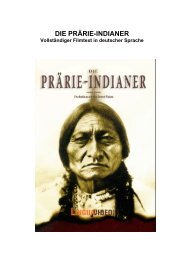The Great Plains Indians Complete Text - Lingua
The Great Plains Indians Complete Text - Lingua
The Great Plains Indians Complete Text - Lingua
You also want an ePaper? Increase the reach of your titles
YUMPU automatically turns print PDFs into web optimized ePapers that Google loves.
Still, the buffalo remained the most important source of clothing right up to the end of<br />
the Indian Wars. <strong>The</strong> buffalo’s tough hide was used to make robes, caps, moccasins,<br />
mittens 125 , leggings, coats and dresses. Women left the fur on for winter garments<br />
and removed it for summer clothes.<br />
While in camp men and women dressed simply for freedom of movement. However<br />
on important ceremonial days they dressed in their finest clothes with the tribe’s<br />
distinctive quill 126 and bead work on display. In colder weather the warrior wore<br />
leggings for warmth. He also wore leggings when hunting or on a raiding party to<br />
protect his legs: leggings were colorful and profusely 127 decorated with paint, bells,<br />
shells, quills or beads. It was as a warrior in a raiding party that the men displayed<br />
their finest garments. Within each tribe distinctive decorations indicated specific<br />
warrior societies. However, individual warriors used paint to show their personal war<br />
honors.<br />
Ceremonial shirts generally known as a war shirt were extensively decorated and<br />
worn during raiding parties. <strong>The</strong>se shirts hung loose and fell well below the waist.<br />
<strong>The</strong> Northern tribes such as the Sioux had the most glorious war shirts. <strong>The</strong><br />
Arapahoe, Cheyenne and Kiowa painted celestial 128 symbols on their war shirts.<br />
Generally the Southern tribes were less adorned.<br />
An Indian’s hair was deemed 129 directly related to the soul and as such was treated<br />
as an adornment 130 . While on a raid it was often decorated with beads and colors to<br />
make it distinctive. Warriors who had counted coups 131 in the battle would wear eagle<br />
feathers as a mark of their bravery. <strong>The</strong> Sioux wore their hair loose as a sign of<br />
humility 132 , some southern and Central <strong>Plains</strong> tribes shaved their heads except for a<br />
short tuft. <strong>The</strong>y often then painted the head as well as the face red. In the golden age<br />
of the <strong>Plains</strong> <strong>Indians</strong> warrior culture their costumes were among the finest ever made<br />
showing distinctive beauty and personality.<br />
Social Structure<br />
It was the well-ordered social structure of the southern Indian nations that enabled<br />
them to thrive 133 in the harsh environment of the plains and desert and battle the U.S.<br />
military to a standstill for nearly 40 years. It was a social structure that was organized<br />
into groupings within groupings. At its base was the family, the next largest group<br />
was the extended family called the clan. After the clans came camps or villages. A<br />
camp could be made up of a single clan or a band which consisted of multiple clans.<br />
Sometimes these clans would be related by marriage and sometimes not. Villages in<br />
turn were spread out over a tribe’s territory.<br />
125<br />
mittens – a type of glove covering four fingers together and the thumb separately – die Fausthandschuhe<br />
126<br />
quill – a large feather from the wing or tail of a bird – die Feder<br />
127<br />
profusely – profuse – in large amounts – stark, überreichlich, übermässig<br />
128<br />
celestial – (attrib) of the sky – Himmels-<br />
129<br />
was deemed – to deem – to consider, to regard – galt als<br />
130<br />
adorned – to adorn – to make more attractive or beautiful especially by adding some type of ornament –<br />
geschmückt, verziert<br />
131<br />
counted coups – (from the French) a warrior who had killed someone in battle and took his scalp – a heroic<br />
warrior – ein besonders erfolgreicher Krieger<br />
132<br />
humility – a modest or low opinion of one’s own importance – die Demut, Bescheidenheit<br />
133<br />
to thrive – to live and grow well and vigorously – gut gedeihen, florieren<br />
<strong>Lingua</strong>-Video.com – Ubierstraße 94 – 53173 Bonn – Tel: 0228 / 85 46 95-0 – Fax: 0228 / 85 46 95-79 18



